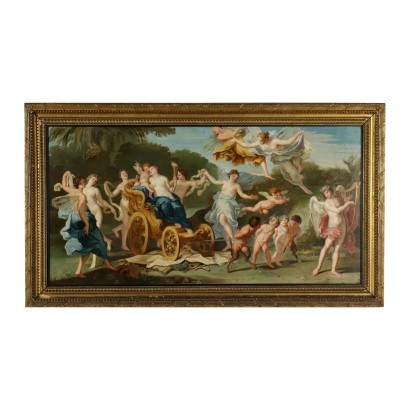Triumph Of Venus Oil On Canvas Late '700 Early '800 - From Cardboard By Carlo Cignani
Features
From Cardboard By Carlo Cignani
Artist: Carlo Cignani (1628-1719) Derived from
Artwork title: Il trionfo di Venere ovvero Il corteo nuziale di Arianna
Age: 18th Century / 1701 - 1800
Subject: Allegorical/Mythological Subject
Artistic technique: Painting
Technical specification: Oil on Canvas
Description : Il trionfo di Venere ovvero Il corteo nuziale di Arianna
Oil on canvas. The painting is an exact copy of the piece by the same name created by Carlo Cignani (1628-1719) for the Room Of Love in Palazzo del Giardino in Parma, commissioned by Duke Ranuccio II Farnese. According to different sources, Cignani only drew the cardboards of the piece, but the transposition to canvas seem to have taken place between 1678 and 1680 by Marcantonio Franceschini (1648 - 1729) and Luigi Quaini (1643-1717), who were his pupils and later his collaborators. The two artists from Bologna, tied by an artistic bond in which the first painted the figures and the second the landscapes, still worked together with Cignani for many of his pieces, and with other students of his they were often busy reporting on frescoes the cardboard drawings of the master. The cardboards of the piece became property of the English consul in Venice, Joseph Smith, bibliophile and patron, who commissioned a "Description of the cardboards drawn by Carlo Cignani and the paintings by Sebastiano Ricci: owned by Mr Giuseppe Smith, consul of Great Britain, in the Serene Republic of Venice, with a compendium of the lifes of the two renowned professors" to Pietro Ercole Gherardi (1687 -1752), university professor, vice-librarian of the Estense court and collaborator of Ludovico Antonio Muratori, edited by Giambattista Pasquali in 1749. In that piece, Gherardi (or maybe cunsul Smith himself) describes the preparing drawing meticulously, "a larger than usual cardboard, on which the appraised Cignani figured out the chiaroscuro of the Triumph of Venus". Consul Smith also decided to have the drawings of both Cignani and Ricci carved and crafted by bulin, commissioning the work to the famous Parisian carver Jean Michel Liotard, to "make (the pieces) visible to those who couldn't see the originals as well". The description of the piece is detailed in every figure and detail. In the great scene the cart stands out in the centre and Venus and Cupid are sitting on it; the carriage is pulled by four small figures, two puttos and two small satyrs, over which another small winged putto flies, armed with a bow; in front of the carriage there is a young boy who plays a ten-stringed harp, who is considered the personification of Pleasure by some. Around and over the carriage, a group of nymphs, of the earth and of the air, with wings dance and twirl, surrounding the deities joyfully. Under the carriage wheels, trampled on and covered by the cloth of a banner, there are different objects: a military emblem, the legionary eagle, a laurel crown, a sword, a shield, a book, an open compass, which could be the symbols of the triumph of Love over War, Art and Literature. According to other interpretations, they could be symbols for the triumph of Venus over the other deities Juno and Pallas, pictured through their symbols, in the Judgement of Paris. According to more recente evaluations, the three paintings by Cignani in the Room of Love of Palazzo Giardino in Parma all trace back to the wedding of Bacchus and Ariadne, and what is traditionally interpreted as a "Triumph of Venus" would actually be the "Nuptial Procession of Ariadne", who is the main character. It is clear how the young girl portraying Ariadne in the two other scenes and particularly in the third one that represents the Wedding of Bacchus and Ariadne, celebrated by the goddess iof Love, is identical in the face, in the pearl arrangement, in the blue cloak to the presumed Venus in the central painting. According to this interpretation, the young boy preceding the procession would actually be Hymen and not Pleasure, portrayed with blond hair and a wreath of "scented marjoram" and with the "candid foot with the yellow sandal", as Catullus describes him in Carme 61. Ariadne's carriage is pulled by two satyrs, typical followers of Bacchus and two Puttos, with ivy crowns, an additional hint to the god. And Cupid, sitting on the carriage next to Ariadne, is pointing his gold arrow against her, to indicate her new love for Bacchus, to which alludes the light up torch between the hands of the young lady as well. The abundance of interpretations and symbols of this piece can be found in the copy here proposed, faithful to the original in very detail. The painting is in its original canvas and has some signs of restorations; the study of the cracking and the canvas, of Northern-European structure, sets the piece at the end of '700, beginning of '800. The painting is presented in a frame from the second half of '800.
Product Condition:
Fair condition. Wear consistent with age and use. Product with a Certificate of Authenticity and Lawful Origin.
Frame Size (cm):
Height: 114
Width: 200
Depth: 7
Artwork dimensions (cm):
Height: 94
Width: 180





























